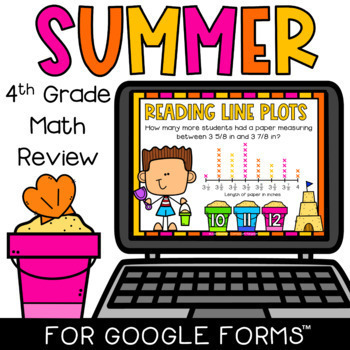End of Year 4th Grade Math Review Summer Escape Room for Google Forms ™
- Google Drive™ folder
- Internet Activities

What educators are saying
Description
This end of year 4th grade math review utilizes Google Forms™ to give students a fun and engaging way to review 4th grade math skills before summer break! In this activity, students are tasked with helping the students in the story dig up seashells by answering a series of 24 challenge questions. They will collect letters to a secret code each time they get two correct answers and will decipher the secret message at the end of the activity. Also includes a printable recording sheet!
Skills reviewed (includes 2 questions per skill):
- Number patterns from a given rule
- Adding and Subtracting 5 digit numbers
- Multiply and divide 4 digits by 1 digit
- Comparing fractions with unlike denominators
- Adding like fractions, including mixed numbers
- Subtracting like fractions, including mixed numbers
- Multiply a fractions by a whole number
- Convert fractions to decimals
- Area and perimeter word problems (finding the length when given the total area and width)
- Line plots with fractions to 8th of an inch (answer questions from the data)
- Additive angles, including finding missing angles
- Identifying lines and angles in polygons
Your feedback is important!
Feedback helps other teachers find great resources for their classroom AND rewards you with credit to use on future TPT purchases! You can leave feedback for purchased and free products from your "My Purchases" page.
Follow me to get 50% off new resources!
Click the green star under my logo (on the right side of this page) to grab my new resources half off for the first 48 hours! All products (excluding bundles) are discounted.





